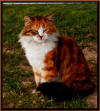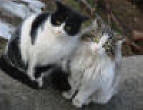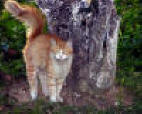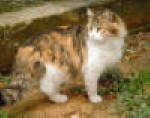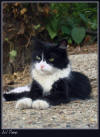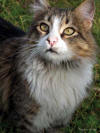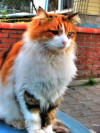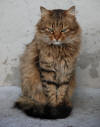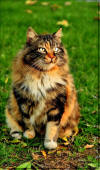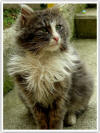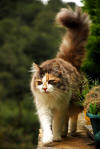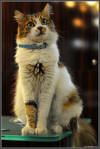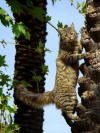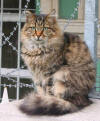|
Departments
eBook now Available!
|
Exclusive - THE book on Traditional & Classic
Siamese cats
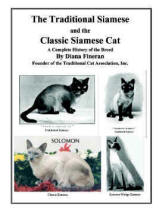
Written by the Founder of TCA, Inc.
Tullycrine
Affordable
Web Design
|
|
|
THE TRADITIONAL
TURKISH ANGORA © FAQs
COPYRIGHT DIANA FINERAN FEBRUARY 14, 2001
TRADITIONAL TURKISH ANGORA BREEDERS
 |
Photos Courtesy of Crystal Arnold
Click on photo to enlarge |
 |
The Traditional Turkish
Angora includes all colors,
patterns, and Traditional
Turkish Angora body types of
Turkish origin, which include
the Ankara Kedisi, the Turkish
Van, the Classic Turkish van,
the Anatolian Cat, the
Aphrodite, and the Van Kedisi.
These are all names for the
same, naturally occurring breed
of cat. The Traditional Turkish
Angora is a long haired,
"biggish sized cat".
History
of the Traditional Turkish
Angora
What the
Turks are saying...
Personality of the Traditional
Turkish Angora
Q: What is the HISTORY of the Traditional Turkish Angora?
A: The Traditional Turkish
Angora has been around for
hundreds and even perhaps
thousands of years and will be
with us for a long time to come.
The history of this magnificent
breed is extensive and rich.
There are several theories
concerning the origin of the
Traditional Turkish Angora. At
some point it is mentioned, that
long-haired breeds (Including
the Traditional Turkish Angora
and the Traditional Persian
(Doll Face)) descended from the
short hair African wildcat,
native to Asia and Africa. The
African wild cat posses the same
chromosome number and structure
as domestic cats, and
interbreeds easily with them. A
different assertion tells us,
that they descended from a wild
cat called the Pallas Cat or the
Manul cat (Otocolobusmanul) a
long haired Asian wildcat,
domesticated by the Tartars and
Chinese, then later by the
Turks. The range of these
original cats occupied the
Caspian Sea, the south shore of
which is Persia (Now Iran).
Iran’s neighbor to the west is
Turkey, whose capital, Ankara,
was formerly called Angora.
Another source stated that they
came from the Lake Van area of
south-eastern Turkey, which
resulted in them being called
"Van Cats" for a while. The long
hair gene is recessive and
probably mutated spontaneously
and was perpetuated over
centuries of inter-breeding in
confined, mountainous regions
such as the Lake Van region,
that limited out crossing. The
district of Van is snowed in for
six months of the year, so these
cats were very hardy, and have
extensive winter coats. However,
it is very hot in Van in the
summer, so the cats shed to a
much lesser coat in the summer
months.
|

|
Photos Courtesy of Crystal Arnold
Click on photo to enlarge |
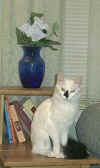
|
Legend has it that Mohammed
(570 – 632), founder of the
Islamic faith, possessed a
Traditional Turkish Angora he
regarded so highly that rather
than disturb it as it slept on
his robe, he cut off the sleeve.
Mohammed’s Traditional Turkish
Angora was reputed to have been
odd-eyed (one blue eye and one
gold eye).
The Traditional Turkish
Angora is believed to have
originally come from Angora,
Turkey, the Persian Province of
Chorazan, Russia and Afghanistan
to Europe in the late 1500’s,
with their principal color being
white. These cats have been
domesticated for centuries, in
fact for as long as the famous
Saluki Hound! Their fur was of
great value to the natives of
Angora, as it formed an
important article of commerce
and was greatly sought after by
merchants of surrounding
countries. The Traditional
Turkish Angora was said to be a
great favorite of the Armenians
and Turks who especially enjoyed
how their unique coat color
contrasted with their oriental
furnishings and for their
exceptional character.
A book about "Feline
Husbandry" was written by Niels
Pedersen, who set forth what he
called the "seven ancient
mutations". One of these
Mutations created long hair in
cats. The others were solid
coloration, tabby striping, the
dilution gene (which causes
colors to produce a lighter
tone), sex-linked orange
coloration, the white spotting
factor and dominant white. Of
course, many other mutations
occurred over the centuries, but
these seven occurred so long
ago, no one knows exactly when
and where they developed. All of
these mutations are seen in the
Traditional Turkish Angora, as
well in other breeds.
When such mutations occur in
isolated areas, like the cold
plateaus of Turkey, this trait
is more likely to be spread
through the existing cat
population. A speculation says
the gene for long hair
spontaneously arose in three
separate areas where cold harsh
climates made the longer,
insulating fur an important part
of survival. These were Russia,
Persia (now Iran) and Turkey.
Because of the unforgiving
environment and high elevations
in Turkey, cats with long fur
had dominance. Another belief is
that the mutation developed in
only one of these places and was
then transported to the others
later. At some point they
manifested the dominant white
gene. Yet they still have a wide
variety of colors and patterns.
The first long haired cats
seen in Europe in the sixteenth
century came from Angora or
Ankara in Turkey. It is from the
Angoras, later called Persians
and later referred to as
long-haired, that by selective
breeding the many colored and
beautifully typed varieties of
today have evolved.
During the 1600’s these
famous cats made their way to
Europe by caravans on the
important Turkish, Russian and
Persian trade routes between
Europe and the Middle East. Rare
animals were a marketable
transport. By 1626 they had
arrived in Italy.
Some breeders claimed that Angoras came to America with
the early settlers. This is an
assertion, though never
documented, that could well be
true.
Numerous color photos
courtesy of The Angora Cat
Association, Turkey
The subject could be brought
up that there is an Angora
Rabbit and an Angora Goat, both
with coats that are long and
silky. However, these names must
have been given to the Rabbit
and Goat breeds long after the
Angora Cat appeared. Angora
sweaters are made from the hair
of these rabbits and goats, but
not from the Traditional Turkish
Angora cats fur.
The French naturalist, Count
de Buffon, observed in the
mid-18th century that
cats in Persia "except in color
bore a perfect resemblance to
the cat of the Angora." Persian
cats were gray, said Buffon,
while Angoras were black, white,
deep red, light fawn, or mottled
gray.
Of interest is a letter addressed to the President of
the French Zoological Society by
M. Lottin de la Val. It dates
from a meeting of this
organization held on May 11,
1856, "When you recently did me
the honor of calling on me, you
imparted the recently held view
that the so called "Angora" cat
does not exist or could not
exist except in the vicinity of
ancient Ancyra. I hasten to
dispel this illusion. I myself
came upon specimens of that
lovely feline species in the
great Armenian plateau, at
Erzerum, where the climate is
greatly different from that of
Angora. The species is very
numerous at Mourch in Kurdistan,
where it is the dominant
variety. I also found it at
Billis and in the Pashalik of
Bayazit.. The finest specimens,
however, which I saw belonged to
the Archbishop of Van, a town in
the east of Kurdistan, on the
frontier of Azerbaidjan. He had
three of them, one pearl grey,
one orange-hued with black and
white flecks, and a third, which
was completely white. Their fur
was magnificent, though there
was thought to be nothing to be
surprised at in them, as such
cats are common in Kurdistan. I
also saw some at the residence
of Khan Mahmoud, Prince of
Hekiars, at Alpeit. I can not
recall having seen any in
Persia, though, had I thought
that scientists might have been
interested, I would have taken
care to seek them out, busy as I
was. But what will surprise you
most of all is that despite the
high temperatures prevailing,
one should find Angora cats at
Bagdad, though certainly these
are not so fine as those to be
found on the northern slopes of
the Medique and Taurus
mountains, though whether the
difference is due to the hot
atmosphere or the hostility of
the people of Bagdad, I cannot
say. You will no doubt settle
that point better than I could,
all I can say is that the people
of Bagdad are in constant
warfare with their cats,
maintaining, not without good
reason, in my opinion, that they
bring the plague, because of
their fur coats and their
habits."
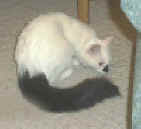 |
Photos Courtesy of
Crystal Arnold
Click on photo to enlarge |
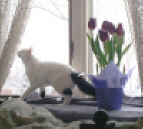
|
Several years before
breeding, showing and keeping
records on cats were thought of,
"The Book of Cats" was written
in 1867 by Charles H. Ross. The
book was surprisingly well
received. In it Mr. Ross gave
descriptions of definite
varieties, for example, "The Cat
of Angora, with silvery hair of
fine silken texture. Some being
yellowish, and others olive,
approaching to the color of the
Lion, but they are all delicate
creatures, and of gentle
dispositions."
Early cat shows were quite
simple compared to today. In
1874 W. Gordon Stables, M.D.,
C.M., R.N, wrote in his book,
"Cats, Their points and
Characteristics, with
Curiosities of Cat Life", "On
judging of long-haired cats very
few words will suffice. The
classes, are tortoiseshell and
White, Tabby, Red Tabby, Pure
White, Black and Unusual Color.
These classes must be judged by:
Markings, which are wanted as
distinct and well arranged as
possible. Size-they ought to be
large cats. Pelage-ought to be
very long, silken and glossy.
The eyes should be of the same
color as in the short-haired
classes. Miss Hale’s Angora, "Selim"
is a very fine specimen, slate
colored on the body, the face
vandyked with white, and a
beautiful snowy apron in front.
His eyes are green and
sparkling, and from his cage he
glares out at you with a look of
surly grandeur, highly
characteristic of his noble
breed. The same lady’s "Zuleika",
a pussy imported from Smyrna, is
a most lovely and engaging
little thing. All white, with
small round head, long haired,
and pitiful eyes, as if it
wanted so much to be petted-in
fact just lived to be loved, and
nothing else. It is a pet fit
for a princess."
|
.jpg)
TA Female
|
.jpg)
TA Female
|
.jpg)
TS Male
|
Photos of Traditional Turkish
Angora cats from the Ankara Zoo
Courtesy of Harvey Harrison -
Breeder of Traditional Turkish
Angora cats. (Circa 2005) (Click
on Photos to enlarge).
In Harrison Weir’s book "Our
Cats and All About Them",
published in1889, He stated,
"The best are of high value, a
pure white with blue eyes, being
thought the perfection of cats,
all other points being good, and
its hearing by no means
defective. The colors are
varied, but the black, which
should have orange eyes, as
should also the slate colors,
and blues, and the white are the
most esteemed." He also told
about an Angora cat, which was
exhibited at Brighton, "This cat
had tinted fur, white with black
tips. It was a beauty with the
white scarcely visible unless
the hair was parted."
In the early days the
Traditional Turkish Angora were
highly treasured, being a status
symbol of the aristocracy. Rumor
has it that one Traditional
Turkish Angora owner turned down
an offer of $5,000 for her
prized Angora at an 1890 cat
show in London. This amount of
money could purchase a
respectable house at that time.
For a time it was assumed
that Traditional Turkish
Angora’s and Traditional
Persians (Doll Face) were
different names for the same
long-haired cat, but this was
not true. Arguments came forth
saying that, "The name "Persian"
would seem to be somewhat of a
misnomer, as it has yet to be
proven that these lovely animals
originated from that country.
Angora seems to be a much better
term." Fifty years after they
came to England and France the
long-haired breeds known at the
time were classified as
"Angoras", "Persians",
"Russians" and "Indians". The
Traditional Turkish Angora was
the most popular.
Numerous color
photos courtesy of The Angora
Cat Association, Turkey
In Frances Simpson’s 1903
"The Book of the Cat", she
provides only minimal
information about this very old
breed, "In classing all
long-haired cats as Persians I
may be wrong, but the
distinctions, apparently with
hardly any difference between
Angoras and Persians are of so
fine a nature that I must be
pardoned if I ignore the class
of cat commonly called Angora,
which seems gradually to have
disappeared from our midst.
Certainly, at our large shows
there is no special
classification given for
Angoras, and in response to many
inquiries from animal fanciers I
have never been able to obtain
any definite information as to
the difference between a Persian
and an Angora cat. Mr. Harrison
Weir, in his book on cats, 1889,
states that the Angora differs
somewhat from the Persian in
that the head is rather smaller
and ears larger, fur more silky
with a tendency to woolliness."
The poet J. Slingsby Roberts
had an Angora Tom, named Soloman,
with emerald eyes.
At the end of the sixteenth
century it is claimed that
Nicholas Claude Fabri de Peirese,
a naturalist, scientist and
archaeologist, introduced the
first Angora to France, and it
is presumed that the cat
actually came from Angora.
|

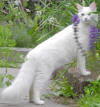 |
Anoush Vahid of Sadakat
Photos Courtesy of
Heather Lane-Lillis
Click on photo to enlarge |
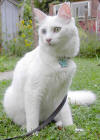 |
The first Traditional Turkish
Angoras are said to have made
their way to Great Britain via
France. From England they
ventured to Germany. The first
organization dealing with
purebred cat breeding was
started in Germany in 1922,
under the name of "1. Deutscher
Angorakatzen-Schultz-and
Zuchtverein (1st. German
Association for the Protection
and Breeding of Angora Cats).
Through this group Herr. K.
Hirschmann organized the first
purebred cat show as early as
1924 in Nuremberg. A wonderful
array of cats appeared in the
cages that contained several
Traditional Turkish Angoras
(still with long noses) and
surprisingly two "Siamese temple
cats (now known as Traditional
Siamese and Classic Siamese)"
with gold plated collars. These
Traditional Turkish Angoras were
the first ever shown in Germany.
Herr Hirschmann was the judge,
basing his show standards on a
booklet from England. More shows
followed in Frankfurt, Berlin,
Dresden and in Rheims in 1933.
Herr Hirschmann had great show
success with his Red Self Angora
cats, whose parents he had
imported from England.
This German Organization
began a Registry and Stud Book
in 1922, with the first entry
being Herr Hirschmann’s "von
Brosame", followed by "Puppi
Edle von Fipsheim", the mother
of numerous prize-winning
kittens. During the 1920’s and
1930’s Berlin played a leading
role in German cat breeding.
During this time Frau L. von
Werner owned a cream Angora,
"Hell von Babelsberg", a
beautiful male from Frau von
Harbou’s breeding. This "Hell
von Babelsberg" was a direct
descendant of the cream tom, "Bincie
of Bredon", from the Wolfsitz
cattery of Baroneess von Larisch.
"Bredon" was a famous British
prefix.
Numerous color
photos courtesy of The Angora
Cat Association, Turkey
In 1947 the Angora was
described as being imposing,
white in color with a
magnificent plumed tail. Even
though they came in several
other colors, breeders at that
time were endeavoring to keep
them only pure white with great
success because white propagates
itself with consistency. The
Angora was considered a parlor
cat, very sensitive to cold and
dampness and consequently
delicate in constitution. Their
owners were warned not to feed
them tripe, giblets, or scraps
of fish, since their digestion
would upset much sooner than
that of other cats. Angoras and
Persians were highly valued when
they were purebreds. Yet, many
young Angoras were sold without
their new owners knowing what
they had purchased. For a while
all long-haired cats were called
"Angoras", and then for a while
they were called "Persians". The
ordinary person made no
distinction between breeds. The
Traditional Turkish Angora, and
Russian Long-hairs were
indiscriminately used
extensively in Traditional
Persian breeding programs to add
length and silkiness to the
Persian coat.
Slowly the term "Angora" in
relationship to long-haired cats
in England was seldom if ever
used in that country. A typical
Angora rarely existed then, so
it was offensive to breeders to
see a number of badly bred,
long-haired cats advertised and
spoken of as Angoras. The
general public in England at the
time thought of any long-haired
cat as an Angora. Even poor
Maine Coons were termed Angoras.
Whatever the Angora was
originally, it had become far
removed from purebred Angoras.
The purebred, imported
long-haired cats were thought to
be a cross of the Angora and the
Persian. The Persian possessed a
rounder head than the Angora.
Also their coats were quite
different. The coat of a Persian
then had a wooly under coat and
a long, hairy outer coat. Their
hair was somewhat shorter on the
shoulders and upper part of the
hind legs. The Angora, on the
other hand, had a long, soft
hair, hanging in locks,
inclining to a slight curl or
wave on the under parts of the
body. Their hair was much longer
on the shoulders and hind legs
than the Persians, and was not
so plentiful nor evenly profuse
as the Persian’s. . The Angora
had a more wedge-shaped head,
compared to the Persians
roundness of face. Of course the
Angoras and Persians of the
1940’s era were constantly
crossed with each other, causing
what was considered a decided
improvement to each breed. Even
Traditional Russian Blues were
used. The long-haired cat of the
1940’s was decidedly more
Persian bred than Angora. The
Persian breeders liked the
resulting long, locky coat,
especially where great length of
coat was produced on the
shoulders and legs.
Numerous color photos
courtesy of The Angora Cat
Association, Turkey
As we see the three breeds
were interbred, and when that
was done, the Traditional
Turkish Angora characteristics
tended to disappear and the
Traditional Persian (Doll Face)
dominated. In time, true
Traditional Turkish Angoras
ceased to exist as a pure breed
and vanished from the western
world. By the 1900’s they had
virtually vanished from America
too. By 1909 Dorothy Champion,
an American Persian breeder,
declared, "That the term
"Angora" should be seldom if
ever used in this country as a
typical Angora scarcely exists.
The long haired cat of today is
decidedly more Persian-bred than
Angora." However, only in the
mid 1950’s was the term
"Persian" adopted as a breed
name. All longhairs simply
continued to be registered as
longhairs, even though the cat
world had been calling them
Persians for more than half a
century.
In England Laura Lushington
and Sponia Halliday played a
role in the Traditional Turkish
Angora breed when they were
given a pair of what they called
"Van kittens" in 1955 while
traveling by car and camping in
Turkey. They decided to bring
them back to England through
rough traveling conditions. The
fact that they did well showing
the wonderful adaptability and
intelligence of their breed.
Once involved in a breeding
program, they proved to breed
absolutely true. This pair of
ladies decided to establish the
breed and push for its
acceptance by the GCCF to save
the breed from eventual
extinction in its present form.
Although domesticated and
privately owned, the cats were
not being bred on a scientific
basis in Turkey. In order to
find new, unrelated Traditional
Turkish Angoras to enlarge their
breeding stock, they had to go
back to Turkey four years later.
The new cats had to go through
the inhumane, British, six
month, quarantine. The first
Registered Traditional Turkish
Angora in Britain was "Van
Guzelli Iskendern", imported by
Miss Lushington in 1955. In 1969
"Turkish Cats’ were accepted by
the GCCF in England. The first
Traditional Turkish Angora open
class Champion was their, "Van
Alanya". The Breed Standard at
this time called for a mostly
white cat with auburn spots on
the forehead and an auburn tail,
ringed in light and dark shades.
It was supposed to have Amber
eyes. One has to wonder if this
was totally for the benefit of
the Lushington/Halliday cats
this describes, or if the whole
breed was even considered.
Numerous color photos
courtesy of The Angora Cat
Association, Turkey
Since 1939 the government of
Turkey in conjunction with The
Ankara Zoo began protecting its
famous breed of cats by
supervising and maintaining a
breeding program. For a lesser
period of time the Zoo in
Istanbul did also. Only white
Angoras with blue and amber eyes
are raised and accurate records
are kept on all the offspring.
Particularly prized is the
odd-eyed Traditional Turkish
Angora, believed to be touched
by Allah, who has one blue eye
and one gold eye. They are
called "Ankara Kedisi" in their
native country. There is an
untrue belief the Turkish
government banned any
exportation of their Traditional
Turkish Angoras in an effort to
preserve their gene pool there.
From P. Aksoy we learn, “There
is no ban or any law like this.
But still you can meet
some Turkish people including
officials who believe in this.”
P.
Aksoy explains about the Zoo,
“The Ankara Zoo was never an
important institution.
The breeding program was
very unscientific.
Volunteers (not even
government employees) collected
any white Angora cat they could
find – the solid white cat they
considered as a “breed”
(including shorthair white cats
which were later separated and
made into the “Van Kedisi” in
the same zoo). The conditions
even today are far from best.
The Ankara Zoo could be a
place for someone who wants to
get a white Angora cat, however
the breeding program makes no
sense as Angora cats freely roam
everywhere in Turkey. Most of
the free roaming cats in Turkey
are “purer” than the pedigreed
“Angora” of the cat fancy.
In conclusion, the
Ankara Zoo did not save
anything, but it is widely used
as a “historical fact” of the
fake Angora and is very over
rated.”
New interest in the breed in
the U.S. began when in 1962
Colonel Walter and Liesa F.
Grant were given special
permission from the Governor of
Ankara to take an unrelated pair
of true Traditional Turkish
Angoras of a type not seen in
the West for many years from
Turkey to the United States.
Fortunately these were purebred
Traditional Turkish Angoras from
the Angora Cat Colony maintained
for many years in the Ankara
Zoo. The female, "Yildizcik"
(Starlet) was amber-eyed, and
the male, "Yildiz" (Star), was
odd-eyed, with one eye brilliant
blue and the other amber.
Perhaps other Angoras had
arrived in North America by
various means, but these two
cats were the first "official"
ones to arrive, complete with
all their records. The Grant’s
brought still another unrelated
pair back from Turkey, under the
same arrangements, in 1966. This
time the eye colors were
reversed with the female,
"Mavis" being odd-eyed with the
male, "Yaman", having amber
eyes. These cats excited a great
deal of comments! Subsequent
importations by Americans
stationed in or traveling
through Turkey provided the
foundation stock used to
reconstruct the Traditional
Turkish Angora as a separate
breed in the U.S. The breed was
accepted in the U.S. in 1973,
due to the instrumental efforts
of the Grants.
Nettie Tuzcu lived in Turkey,
when the Zoo was doing its
breeding program. She
remembered, "They had these
cats-a few breeding pairs-at the
Ankara Zoo." She admired the
caged cats so much, she
persuaded her husband’s uncle,
who just happened to be the
Minister of Agriculture, to get
her a pair. That marked the
beginning of her lifelong love
affair with the regal breed.
Tuzcu bred and cared for the
cats, while living in Turkey,
then took them with her when she
moved to the U.S.
Numerous color photos
courtesy of The Angora Cat
Association, Turkey
Perhaps because only white
cats were used in the Breeding
program of the Ankara Zoo, this
color predominates in the breed
today. However, there are
recessive genes to other colors
that can arrive in litters from
time to time. The white color is
dominant, therefore a white cat
must always have at least one
white parent. It can never be a
throwback. “Once the American
registries recognized the
Traditional Turkish Angora, they
registered many unknown cats,
states P. Aksoy, “including
those that probably even did not
come from Turkey. I myself
studies numerous “Turkish
Angora” pedigrees.
Many cats have no records
of their origin, some breeders
like Taspinar/Tai-phoon (cats
used in Azima breeding
excessively) were known for
their bad reputation (breeding
their “Angoras” with various
cats including Siamese and
Persians whose recessive colors
are still alive in the USA and
EU Angora breeding programs).
American breeders did mistakes
and those mistakes turned to a
weird looking, thin boned breed
they call “Turkish Angora”.
No wonder, when we
compare DNA of cats from Turkey
and those “cat show champions”,
they turn to completely
unrelated breeds!.” What’s more
CFA refused to register
non-white Traditional Turkish
Angoras until 1978,
sometime
after the other associations had
recognized the breed in a
variety of colors. This is why
most of the Traditional Turkish
Angoras in the U.S. are white.
The first U.S. Grand Champion
was No Ruz Kristal of Azima.,
bred by Elain Gesel of
Bowmanville, N.Y.and owned by
Barbara Azan of Azima Cattery in
New York.
Another early breeder in the
U.S. was Barbara Azan of Azima
Cattery in New York, who was
instrumental in getting the
breed recognized and popularized
in the United States and in
exporting examples of the breed
to other parts of the world.
Luckily for all of us who
enjoy cats, the ancient long
haired breed the Traditional
Turkish Angora has made its way
in the world, respected and
loved by those who know them
well.
Traditional Turkish Angora’s
still roam the countryside and
villages of their native Turkey
today, virtually unchanged
through many centuries. A
Turkish word best summarizes the
breed, which is "yaman", meaning
strong, smart and capable.
Source: P. Aksoy, The Angora
Cat Association (Ankara Kedisi
Dernegi) Turkey.
https://turkishangoracat.org/
What are those in Turkey saying
about the TTA?
Good News For The Traditional
Turkish Angora (added
3/10/13)
More History on the
Traditional Angora
https://angoraturkish.blogspot.com/
https://turkishangoracat.wordpress.com/
What is the PERSONALITY of the Traditional Turkish Angora?
The Traditional Turkish
Angora is second to none.
Strong, adaptable, lively,
mischievous, friendly, docile,
poised, regal, graceful,
beautiful, and elegant, they are
truly the aristocrats of the
long-hairs. Usually they are
gentle and easy to get along
with, who make colorful,
affectionate, playful pets. The
whole house is their cat toy
with any small object becoming a
hockey puck. Climbing on
furniture, door tops and
shelves, while looking down at
their owner is normal fun to
them. They bond with their
owners completely and are not
happy unless they are right in
the middle of things. A good
conversation is always enjoyed,
as they can keep up their end of
the dissertation. A determined
nature makes it difficult to
change their mind once they get
an idea into their head.
Extremely intelligent, they are
quick to learn simple tricks,
such as fetching or playing
catch with a soft ball. Helping
to make beds, cook, and do
laundry is on their "to do"
list. If nothing is going on,
they will make something happen.
They can solve a problem and are
eager to "show off" to company.
They will tolerate being held
for only a short time before
wanting down to bat at sunbeams
and chase toys. Even kittens are
capable of jumping to your eye
level from a standing start,
when chasing a toy. Described as
"pure poetry in motion",
"animated, fluid grace", "Living
sculptures in fur", and "there’s
nothing better on four paws",
owners are always emphatic about
the wonderful temperament and
personality of this breed. Their
symmetry and devotion evoke
strong responses of loyalty from
their human family.
Numerous color photos
courtesy of The Angora Cat
Association, Turkey
Unlike other long-haired
breeds, the Traditional Turkish
Angora does not need a lot of
grooming, because they have no
wooly, downy undercoat. Their
fur doesn’t mat the way a
Persians is prone to do. They
keep themselves very clean. A
once a week combing does them
well. Some of their owners claim
that their usual allergies or
asthma don’t flare up around
Traditional Turkish Angoras,
perhaps because of their single
coat.
In additional to their great
capacity for affection and alert
intelligence, their outstanding
characteristic is their liking
for water, not usually regarded
as a feline attribute. Not every
Traditional Turkish Angora
enjoys water, but many do. Those
who do not only dabble in water
and play with it, but have been
known to voluntarily enter ponds
and even warm horse-troughs for
a swim. Even when young kittens
they swim in shallow streams and
still water. They soon became
famous as the ‘swimming cats".
As parents, they have
healthy, robust kittens with
little difficulty and with much
enjoyment from courtship to the
raising of their kittens.
What is the HEALTH of the Traditional Turkish Angora?
Unfortunately, as in most
breeds of white colored cats,
partial or total deafness can
occur, especially in the
blue-eyed, and odd-eyed cats.
This is not a defect of the
breed, but rather a defect in
the dominant gene that produces
white coat color and blue eyes
in cats. They are no more prone
to this than any other breed.
The odd-eyed Traditional Turkish
Angoras are generally only deaf
in one ear; the blue eyed side.
While hearing impaired
Traditional Turkish Angoras must
be kept out of harm’s way, they
otherwise enjoy life just as
much as their hearing cats and
they usually adapt to their
hearing loss remarkably well.
Historical Record © March
2002
Diana Fineran
|
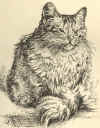
|
Click on pictures to enlarge |
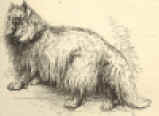
|
These 1889 drawings done by
Harrison Weir, the father of cat
shows, are of great historical
importance because they present
the breed as it originally was
and as The Traditional Cat
Association, Inc. (TCA, INC.)
recognizes it today. A
favorite of the Turks and the
Armenians, the Traditional
Turkish Angora was mentioned by
writers as early as
the1780's.
|

|
Click on pictures to enlarge |

|
As the author
of this presentation, I was
honored to be contacted by
Barbara Azan of Azima Turkish
Angoras, who has been breeding
them for 35 years now. Her
comments about my article are,
"My Cattery was established in
1969. I am astonished at
the wealth of information that
you have gathered about the
Turkish Angoras. It is an
amazingly good article,
incorporating a great deal of
thorough research."
Top of Page
|
|
|
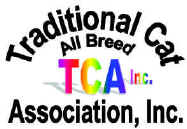
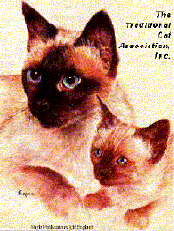 The
Traditional Cat Association,
Inc.©1987®TM
Official Website
The
Traditional Cat Association,
Inc.©1987®TM
Official Website
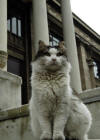
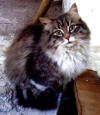
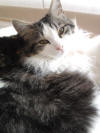
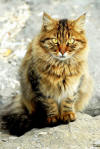
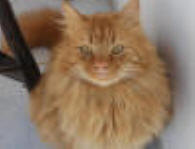
.jpg)
.jpg)
.jpg)
